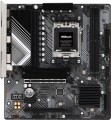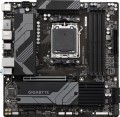Power phases
The number of processor power phases provided on the motherboard.
Very simplistically, phases can be described as electronic blocks of a special design, through which power is supplied to the processor. The task of such blocks is to optimize this power, in particular, to minimize power surges when the load on the processor changes. In general, the more phases, the lower the load on each of them, the more stable the power supply and the more durable the electronics of the board. And the more powerful the CPU and the more cores it has, the more phases it needs; this number increases even more if the processor is planned to be overclocked. For example, for a conventional quad-core chip, only four phases are often enough, and for an overclocked one, at least eight may be needed. It is because of this that powerful processors can have problems when used on inexpensive low-phase motherboards.
Detailed recommendations on choosing the number of phases for specific CPU series and models can be found in special sources (including the documentation for CPU itself). Here we note that with numerous phases on the motherboard (more than 8), some of them can be virtual. To do this, real electronic blocks are supplemented with doublers or even triplers, which, formally, increases the number of phases: for example, 12 claimed phases can represent 6 physical blocks with doublers. However, virtual phases are much inferior to real ones in terms of capabilities — in fact, t...hey are just additions that slightly improve the characteristics of real phases. So, let's say, in our example, it is more correct to speak not about twelve, but only about six (though improved) phases. These nuances must be specified when choosing a motherboard.
Size (HxW)
Motherboard dimensions in height and width. It is assumed that the traditional placement of motherboards is vertical, so in this case one of the dimensions is called not the length, but the height.
Motherboard sizes are largely determined by their form factors (see above), however, the size of a particular motherboard may differ slightly from the standard adopted for this form factor. In addition, it is usually easier to clarify the dimensions according to the characteristics of a particular motherboard than to look for or remember general information on the form factor. Therefore, size data can be given even for models that fully comply with the standard.
The third dimension — thickness — is considered less important for a number of reasons, so it is often omitted.
DDR5
The number of slots for DDR5 RAM, provided in the motherboard.
DDR5 is being introduced to replace the fourth version of the DDR standard from the end of 2020. It provides for approximately a twofold increase in memory subsystem performance and increased bandwidth compared to DDR4. Instead of a single 64-bit data channel, DDR5 uses a pair of independent 32-bit channels that work with 16-byte packets and allow 64 bytes of information to be delivered per clock on each channel. New memory modules require a voltage of 1.1 V, and the maximum volume of one DDR5 bar can reach an impressive 128 GB.
Max. clock frequency
The maximum RAM clock speed supported by the motherboard. The actual clock frequency of the installed RAM modules should not exceed this indicator — otherwise, malfunctions are possible, and the capabilities of the “RAM” cannot be used to the fullest.
For modern PCs, a RAM frequency of
1500 – 2000 MHz or
less is considered very low,
2000 – 2500 MHz is modest,
2500 – 3000 MHz is average,
3000 – 3500 MHz is above average, and the most advanced boards can support frequencies of
3500 – 4000 MHz and even
more than 4000 MHz.
Max. memory
The maximum amount of RAM that can be installed on the motherboard.
When choosing according to this parameter, it is important to take into account the planned use of the PC and the real needs of the user. So, volumes
up to 32 GB inclusive are quite enough to solve any basic problems and run games comfortably, but without a significant reserve for an upgrade.
64 GB is the optimal option for many professional use cases, and for the most resource-intensive tasks like 3D rendering,
96 GB or even
128 GB of memory will not be a limit. The most “capacious” motherboards are compatible with volumes of
192 GB or
more - they are mainly top-end solutions for servers and HEDT (see “In the direction”).
You can choose this parameter with a reserve – taking into account a potential RAM upgrade, because installing additional RAM sticks is the simplest way to increase system performance. Taking this factor into account, many relatively simple motherboards support very significant amounts of RAM.
M.2 version
The version of the M.2 interface determines both the maximum data transfer rate and the supported devices that can be connected via physical M.2 connectors (see the corresponding paragraph).
The version of the M.2 interface in the specifications of motherboards is usually indicated by the number of connectors themselves and by the PCI-E revision provided for in each of them. For example, the entry “3x4.0” means three connectors capable of supporting PCI-E 4.0; and the designation “2x5.0, 1x4.0” means a trio of connectors, two of which support PCI-E 4.0, and another one supports PCI-E 5.0.
PCI-E 16x slots
Number of PCI-E (PCI-Express) 16x slots installed on the motherboard.
The PCI Express bus is used to connect various expansion cards — network and sound cards, video adapters, TV tuners and even SSD drives. The number in the name indicates the number of PCI-E lines (data transfer channels) supported by this slot; the more lines, the higher the throughput. 16 lanes is the largest number found in modern PCI Express slots and cards (more is technically possible, but the connectors would be too bulky). Accordingly, these slots are the fastest: they have a data transfer rate of 16 GB / s for PCI-E 3.0 and 32 GB / s for version 4.0 (for more information about the versions, see "PCI Express Support").
Separately, we note that it is PCI-E 16x that is considered the optimal connector for connecting video cards. However, when choosing a motherboard with several such slots, it is worth considering the PCI-E modes supported by it (see below). In addition, we recall that the PCI Express interface allows you to connect boards with a smaller number of lines to connectors with numerous lines. Thus, PCI-E 16x will fit any PCI Express card.
It is also worth mentioning that in the design of modern "motherboards" there are slots of increased sizes — in particular, PCI-E 4x, corresponding in size to PCI-E 16x. However, the type of PCI-E slots in our catalog is indicated by the actual throughput; so only connectors that support 16x speed are considered as PCI-E 16x.
PCI Modes
Operating modes of PCI-E 16x slots supported by the motherboard.
For more information about this interface, see above, and information about the modes is indicated if there are several PCI-E 16x slots on the board. This data specifies at what speed these slots can operate when expansion cards are connected to them at the same time, how many lines each of them can use. The fact is that the total number of PCI-Express lanes on any motherboard is limited, and they are usually not enough for the simultaneous operation of all 16-channel slots at full capacity. Accordingly, when working simultaneously, the speed inevitably has to be limited: for example, recording 16x / 4x / 4x means that the motherboard has three 16-channel slots, but if three video cards are connected to them at once, then the second and third slots will be able to give speed only to PCI-E 4x level. Accordingly, for a different number of slots and the number of digits will be appropriate. There are also boards with several modes — for example, 16x/0x/4 and 8x/8x/4x (0x means that the slot becomes inoperable altogether).
You have to pay attention to this parameter mainly when installing several video cards at the same time: in some cases (for example, when using SLI technology), for correct operation of video adapters, they must be connected to slots at the same speed.
CrossFire (AMD)
Motherboard support for
AMD's Crossfire technology.
This technology allows you to connect several separate AMD graphics cards to a PC at once and combine their computing power, respectively increasing the system's graphics performance in specific tasks. Accordingly, this feature means that the "motherboard" is equipped with at least two slots for video cards — PCI-E 16x; in general, Crossfire allows up to 4 separate adapters to be connected.
Such functionality is especially important for demanding games and "heavy" tasks like 3D rendering. However, note that in order to use several video cards, this possibility must also be provided in the application running on the computer. So in some cases, one powerful video adapter is more preferable than several relatively simple ones with the same total amount of VRAM.
A similar technology from NVIDIA is called SLI (see below). Crossfire differs from it mainly in three points: the ability to combine video adapters with different models of graphics processors (the main thing is that they are built on the same architecture), no need for additional cables or bridges (video cards interact directly via the PCI-E bus) and somewhat lower cost (allowing the use of this technology even in low-cost "motherboards"). Thanks to the latter, almost all motherboards with SLI also support Crossfire, but not vice versa.

